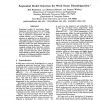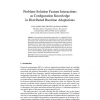862 search results - page 2 / 173 » A Solution for the Problem of Interactive Disambiguation |
ANLP
1997
14 years 6 days ago
1997
Statistical models of word-sense disambiguation are often based on a small number of contextual features or on a model that is assumed to characterize the interactions among a set...
FIW
2009
13 years 8 months ago
2009
Abstract. Current generative programming approaches use configuration knowledge to automatically manufacture an end product given a particular requirements specification. Such conf...
AAAI
2004
14 years 7 days ago
2004
Since the state space of most games is a directed graph, many game-playing systems detect repeated positions with a transposition table. This approach can reduce search effort by ...
SDM
2007
SIAM
14 years 8 days ago
2007
SIAM
When non-unique values are used as the identifier of entities, due to their homonym, confusion can occur. In particular, when (part of) “names” of entities are used as their ...
IJCV
2007
13 years 10 months ago
2007
The neural mechanisms underlying motion segregation and integration still remain unclear to a large extent. Local motion estimates often are ambiguous in the lack of form features,...


